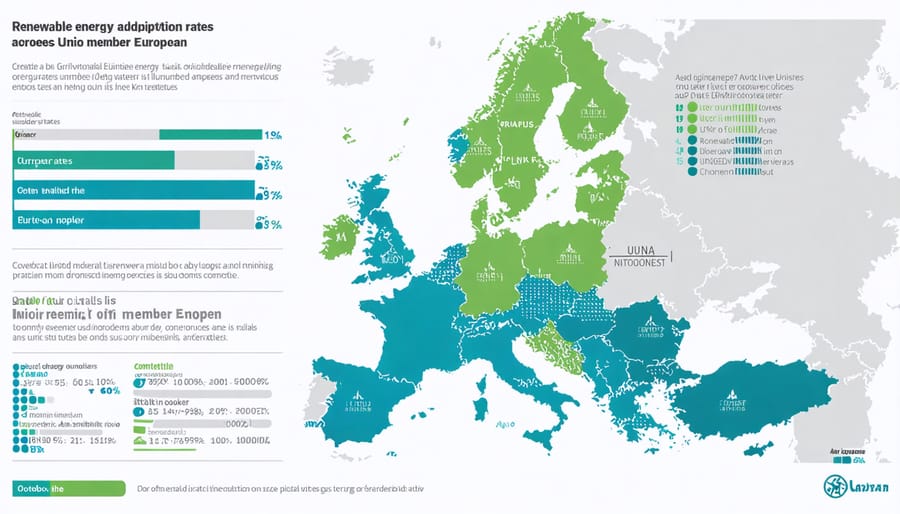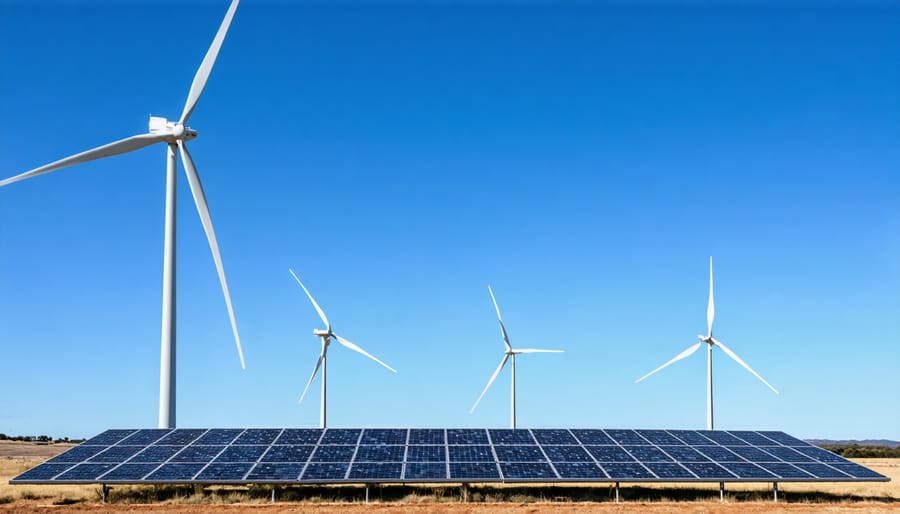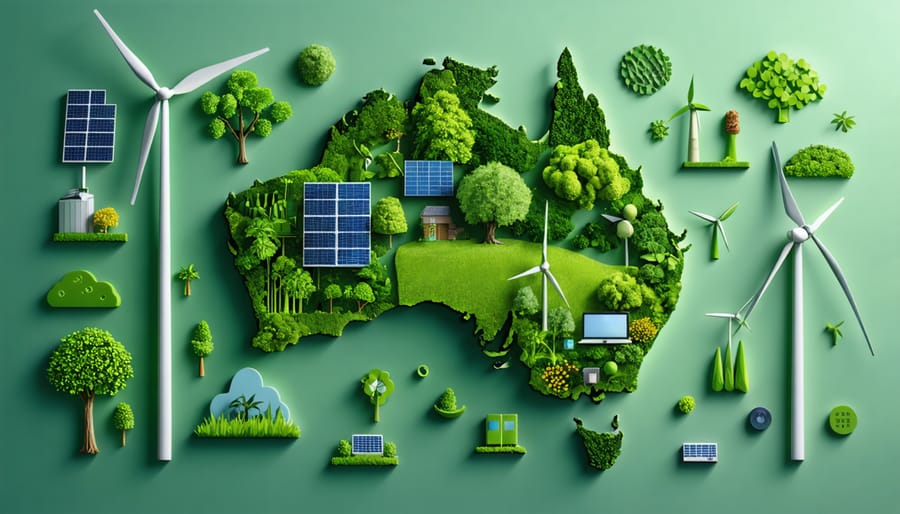Renewable energy standards across Australian states are rapidly revolutionizing Australia’s green energy future, setting new benchmarks for global sustainability practices. From Victoria’s ambitious 50% renewable target by 2030 to South Australia’s world-leading 68% renewable electricity generation, state-level commitments are reshaping our nation’s energy landscape. These standards represent more than just environmental policy—they’re driving economic transformation, creating thousands of clean energy jobs, and positioning Australia as a renewable energy superpower in the Asia-Pacific region.
State-by-state variations in renewable energy requirements reflect local resources, infrastructure capabilities, and community needs. While Queensland harnesses its abundant solar potential with massive solar farms, Tasmania leverages its hydroelectric advantages to achieve 100% renewable electricity. This diversity in approach demonstrates how regional solutions can contribute to national climate goals while maintaining energy security and affordability.
For industry stakeholders, these evolving standards present unprecedented opportunities in bioenergy development, grid modernization, and clean technology innovation. Understanding these state-specific requirements is crucial for businesses planning renewable energy investments and communities transitioning to sustainable power sources.
Global Leaders in Renewable Energy Standards
European Union’s Benchmark Standards
The European Union stands as a global leader in renewable energy standards, setting ambitious targets through its Renewable Energy Directive (RED II). This comprehensive framework requires member states to collectively achieve 32% renewable energy consumption by 2030, with individual countries establishing their own heightened targets. For instance, Denmark aims for 100% renewable electricity by 2030, while Germany targets 65% renewable power generation by the same year.
The EU’s bioenergy certification system serves as a gold standard worldwide, implementing strict sustainability criteria and greenhouse gas savings requirements. These standards ensure that bioenergy production doesn’t compete with food crops or harm biodiversity. The certification process tracks the entire supply chain, from feedstock sourcing to final energy production, providing a model that many Australian states are now studying.
What sets the EU framework apart is its holistic approach to renewable energy integration. Beyond just setting targets, it establishes clear guidelines for grid integration, energy storage, and cross-border cooperation. The success of this approach is evident in countries like Sweden, which already sources over 54% of its energy from renewables.
For Australian stakeholders, the EU’s experience offers valuable lessons in creating robust renewable energy frameworks. Their system demonstrates how clear standards, coupled with strong enforcement mechanisms, can drive rapid renewable energy adoption while ensuring environmental protection and economic growth.

North American Standards Framework
Across North America, renewable energy standards have evolved into a dynamic patchwork of commitments, with U.S. states and Canadian provinces leading the charge toward a sustainable future. In the United States, more than 30 states have established Renewable Portfolio Standards (RPS), with ambitious targets ranging from 20% to 100% renewable energy adoption by 2050.
California stands as a pioneering force, mandating 100% carbon-free electricity by 2045, while Hawaii became the first state to commit to 100% renewable energy by 2045. New York and Massachusetts have followed suit with equally ambitious targets, demonstrating the growing momentum for clean energy transition at the state level.
In Canada, provinces have developed their own unique approaches. Ontario eliminated coal-fired power generation in 2014, while British Columbia generates over 90% of its electricity from renewable sources, primarily hydropower. Quebec leads with its comprehensive Energy Policy 2030, targeting significant increases in renewable energy production and biofuel use.
These standards have catalyzed remarkable growth in renewable energy markets, driving innovation and investment across both countries. States like Iowa and Texas have exceeded their initial RPS goals, particularly in wind energy development, while Maine and Vermont have established themselves as leaders in biomass energy utilization.
The framework’s flexibility allows states and provinces to tailor their renewable energy mix to local resources and needs, creating a robust and diverse clean energy landscape across North America.
Australian State-by-State Analysis

Leading States in Bioenergy Adoption
Several states across Australia have emerged as trailblazers in bioenergy adoption, setting impressive benchmarks for renewable energy standards. Queensland leads the pack with its innovative approach to converting sugarcane waste into bioenergy, powering thousands of homes while supporting the agricultural sector. The state’s success stems from its comprehensive Biofutures 10-Year Roadmap, which has attracted significant investment and created new jobs in regional communities.
Victoria has made remarkable strides through its Waste to Energy initiative, transforming municipal organic waste into clean energy. The state’s commitment to reducing landfill while generating renewable power has inspired similar programs nationwide. Notable success stories include the Yarra Valley Water treatment facility, which now produces enough biogas to power its own operations and feed excess energy back into the grid.
South Australia demonstrates how strong renewable standards can drive innovation in the bioenergy sector. The state’s partnership with local farmers has established a network of small-scale biogas plants that process agricultural waste into energy. This decentralized approach has not only boosted energy security but also provided farmers with additional income streams.
Western Australia’s focus on forestry waste utilization has created a sustainable model for bioenergy production. The state’s stringent renewable standards have encouraged timber companies to convert previously discarded materials into valuable energy resources, creating a win-win situation for both industry and environment.
New South Wales showcases the power of urban-rural collaboration through its Regional Bioenergy Development Program. By connecting city waste management systems with rural energy production facilities, the state has created an efficient circular economy model that other regions are eager to replicate.
These success stories highlight how well-designed renewable standards can drive innovation, create economic opportunities, and accelerate the transition to sustainable energy sources. The ripple effects of these initiatives extend beyond environmental benefits, fostering regional development and energy independence.
Emerging State Initiatives
Several Australian states are making bold moves toward renewable energy adoption, with innovative state-level renewable initiatives gaining momentum across the country. Victoria has recently announced an ambitious target of 95% renewable energy by 2035, supported by a comprehensive framework that includes community solar programs and grid modernization efforts.
Queensland is pioneering a groundbreaking renewable energy zones initiative, transforming former coal regions into clean energy hubs. The state’s planned investment of $2 billion in renewable infrastructure demonstrates its commitment to sustainable power generation while creating thousands of green jobs.
South Australia continues to push boundaries with its virtual power plant program, connecting residential solar and battery systems to create a networked clean energy resource. This innovative approach has caught the attention of other states, with New South Wales and Western Australia developing similar programs.
Tasmania is exploring ways to leverage its abundant hydroelectric resources, proposing new pumped hydro projects that could serve as a renewable energy battery for the mainland. Meanwhile, the Northern Territory is developing solar-powered microgrids to provide reliable clean energy to remote communities.
These emerging initiatives reflect a growing recognition of renewable energy’s crucial role in Australia’s future. States are increasingly incorporating bioenergy into their renewable portfolios, with several pilot projects demonstrating the potential of agricultural waste and sustainable forestry products as reliable energy sources.
The trend toward more ambitious state-based targets and innovative implementation strategies suggests a promising future for renewable energy in Australia, with each state contributing unique solutions to the national clean energy transition.
Areas for Improvement
While many states have made significant progress in renewable energy adoption, several regions still have opportunities for strengthening their standards and accelerating the transition to clean energy. States like Wyoming, West Virginia, and Alabama currently lack mandatory renewable energy targets, presenting a clear pathway for improvement through the implementation of comprehensive standards.
Some states with existing standards could benefit from more ambitious targets. For instance, South Carolina’s voluntary goal of 2% renewable energy could be elevated to a mandatory requirement with higher percentages, following the successful models of leading states like California and Hawaii. Similarly, Kansas’s renewable energy standard has remained static at 20% since 2020, suggesting room for increased targets to drive further innovation and investment.
Implementation timelines present another area for enhancement. States with distant target dates could accelerate their schedules, taking advantage of rapidly improving technology and decreasing costs of renewable infrastructure. Additionally, some states’ definitions of qualifying renewable sources could be expanded to include emerging technologies like green hydrogen and advanced bioenergy solutions.
Enforcement mechanisms vary significantly across states, with some lacking robust compliance systems. Strengthening these frameworks through clear penalties for non-compliance and regular progress monitoring would ensure more effective implementation. States could also benefit from introducing interim targets and regular review periods to maintain momentum and adjust strategies as needed.
The integration of energy storage requirements and grid modernization plans into renewable standards represents another opportunity for improvement. By addressing these infrastructure needs alongside renewable targets, states can create more comprehensive and achievable clean energy transitions.
International Certification Impact
Harmonizing Standards
Australia’s renewable energy landscape is increasingly aligning with international certification standards, creating a more unified approach to sustainable energy development. States are working collaboratively to bridge the gap between local requirements and global benchmarks, particularly in areas such as bioenergy production and solar implementation.
Victoria and South Australia have taken the lead by adopting certification processes that mirror European Union standards, making it easier for Australian renewable energy projects to attract international investment and recognition. Queensland has implemented a harmonization program that allows renewable energy certificates to be recognized across multiple jurisdictions, streamlining the process for energy providers operating across state borders.
The Australian Clean Energy Regulator has established a framework that helps states align their renewable energy targets with international best practices while maintaining flexibility for local conditions. This approach has proven particularly successful in New South Wales, where renewable energy projects now seamlessly integrate with global sustainability frameworks.
Western Australia’s Renewable Energy Alliance has pioneered a certification pathway that connects local producers with international markets, demonstrating how state-level initiatives can achieve global recognition. These harmonization efforts are creating new opportunities for cross-border collaboration and technology transfer, positioning Australia as a leader in renewable energy standardization.

Future Opportunities
The harmonization of renewable energy standards across states presents exciting opportunities for accelerating sustainable development and enhancing cross-border collaboration. As global renewable markets become increasingly interconnected, aligned standards can significantly reduce compliance costs and streamline project development.
A unified approach to renewable energy standards could unlock tremendous potential for knowledge sharing and technology transfer between states. By adopting consistent certification processes and measurement criteria, states can create more efficient pathways for renewable energy projects and attract increased investment. This alignment would particularly benefit emerging technologies like bioenergy, where standardized quality assessments and sustainability criteria could accelerate market growth.
Looking ahead, stronger international standard alignment could foster innovation through healthy competition while maintaining high environmental safeguards. States that harmonize their standards may see enhanced opportunities for renewable energy trading, simplified reporting mechanisms, and improved access to international funding.
For Australia, this presents a golden opportunity to position itself as a leader in renewable energy standard development. By actively participating in international standard-setting processes and sharing our expertise in areas like bioenergy certification, we can help shape future frameworks while ensuring they remain practical and achievable for all stakeholders.
The global shift towards renewable energy standards continues to gain momentum, with Australian states leading significant changes in policy and implementation. Our analysis reveals a clear trend towards more ambitious renewable energy targets across different jurisdictions, with some states pushing beyond the national baseline to achieve impressive results.
The success stories we’ve witnessed, particularly in South Australia and Tasmania, demonstrate that achieving high renewable energy penetration is not just possible but economically beneficial. These states have shown that with the right policy framework and industry support, the transition to renewable energy can create jobs, attract investment, and build more resilient communities.
Looking ahead, the outlook for renewable energy standards is promising. More states are expected to strengthen their renewable energy commitments, driven by technological advances, falling costs, and growing public support for clean energy solutions. The emergence of innovative financing mechanisms and improved grid integration strategies will likely accelerate this transition.
However, success will require continued collaboration between government bodies, industry stakeholders, and communities. The harmonisation of standards across states, while maintaining flexibility for local conditions, will be crucial for creating a more efficient and effective renewable energy network.
As we move towards 2030 and beyond, the role of state-based renewable energy standards will become increasingly important in driving Australia’s clean energy future. The lessons learned from current implementations will help shape more effective policies and create a blueprint for other regions to follow.

